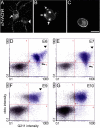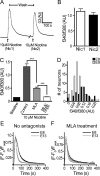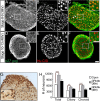Cell-autonomous inhibition of alpha 7-containing nicotinic acetylcholine receptors prevents death of parasympathetic neurons during development
- PMID: 17959793
- PMCID: PMC2919487
- DOI: 10.1523/JNEUROSCI.3057-07.2007
Cell-autonomous inhibition of alpha 7-containing nicotinic acetylcholine receptors prevents death of parasympathetic neurons during development
Abstract
Neurotrophic molecules are key retrograde influences of cell survival in the developing nervous system, but other influences such as activity are also emerging as important factors. In the avian ciliary ganglion, half the neurons are eliminated between embryonic day 8 (E8) and E14, but it is not known how cell death is initiated. Because systemic application of alpha7-nicotinic acetylcholine receptor (nAChR) antagonists prevents this cell loss, we examined differences in receptor densities and responses of intracellular calcium to nicotine using the calcium-sensitive dye fura-2. In addition, we determined whether cell-autonomous inhibition of alpha7 activation in neurons prevented cell death. E8 neurons are heterogeneous with respect to alpha7-nAChR density, which leads to large increases in [Ca2+]i in some neurons; E8 neurons also exhibit a slower rate of Ca2+ decay after nicotinic stimulation than E13 neurons. Expressing alpha-bungarotoxin that is tethered to the membrane by a glycosylphosphatidylinositol linkage (GPIalpha btx) in ciliary ganglion neurons with the retroviral vector RCASBP(A) blocks increases in intracellular calcium induced by nicotine through alpha7-nAChRs and prevents neurons from dying. Expression of GPIalpha btx in surrounding non-neural tissues, but not in neurons, does not prevent cell loss. Furthermore, the GPIalpha btx is not efficiently expressed in the accessory oculomotor neurons, eliminating preganglionic inputs as another site for action of the antagonist. These results support the hypothesis that cholinergic inputs facilitate cell death in the developing autonomic nervous system by activating alpha7-nAChRs, possibly by leading to increases in intracellular calcium that exceed the threshold for cell survival.
Figures






Similar articles
-
Reversible inhibition of GABAA receptors by alpha7-containing nicotinic receptors on the vertebrate postsynaptic neurons.J Physiol. 2007 Mar 15;579(Pt 3):753-63. doi: 10.1113/jphysiol.2006.124578. Epub 2007 Jan 4. J Physiol. 2007. PMID: 17204496 Free PMC article.
-
Prostate stem cell antigen is an endogenous lynx1-like prototoxin that antagonizes alpha7-containing nicotinic receptors and prevents programmed cell death of parasympathetic neurons.J Neurosci. 2009 Nov 25;29(47):14847-54. doi: 10.1523/JNEUROSCI.2271-09.2009. J Neurosci. 2009. PMID: 19940180 Free PMC article.
-
Extrasynaptic alpha 7-nicotinic acetylcholine receptor expression in developing neurons is regulated by inputs, targets, and activity.J Neurosci. 2002 Sep 15;22(18):8101-9. doi: 10.1523/JNEUROSCI.22-18-08101.2002. J Neurosci. 2002. PMID: 12223564 Free PMC article.
-
Brain-derived neurotrophic factor and trkB signaling in parasympathetic neurons: relevance to regulating alpha7-containing nicotinic receptors and synaptic function.J Neurosci. 2004 May 5;24(18):4340-50. doi: 10.1523/JNEUROSCI.0055-04.2004. J Neurosci. 2004. PMID: 15128848 Free PMC article.
-
The alpha7 nicotinic acetylcholine receptor in neuronal plasticity.Mol Neurobiol. 1999 Aug;20(1):1-16. doi: 10.1007/BF02741361. Mol Neurobiol. 1999. PMID: 10595869 Review.
Cited by
-
The Terebridae and teretoxins: Combining phylogeny and anatomy for concerted discovery of bioactive compounds.BMC Chem Biol. 2010 Sep 17;10:7. doi: 10.1186/1472-6769-10-7. BMC Chem Biol. 2010. PMID: 20849634 Free PMC article.
-
Cholinergic modulation of cognitive processing: insights drawn from computational models.Front Behav Neurosci. 2012 Jun 13;6:24. doi: 10.3389/fnbeh.2012.00024. eCollection 2012. Front Behav Neurosci. 2012. PMID: 22707936 Free PMC article.
-
Upregulation of alpha7 Nicotinic Receptors by Acetylcholinesterase C-Terminal Peptides.PLoS One. 2009;4(3):e4846. doi: 10.1371/journal.pone.0004846. Epub 2009 Mar 16. PLoS One. 2009. PMID: 19287501 Free PMC article.
-
A dominant mutation in a neuronal acetylcholine receptor subunit leads to motor neuron degeneration in Caenorhabditis elegans.J Neurosci. 2010 Oct 20;30(42):13932-42. doi: 10.1523/JNEUROSCI.1515-10.2010. J Neurosci. 2010. PMID: 20962215 Free PMC article.
-
Rosiglitazone inhibits alpha4 nicotinic acetylcholine receptor expression in human lung carcinoma cells through peroxisome proliferator-activated receptor gamma-independent signals.Mol Cancer Ther. 2009 Jan;8(1):110-8. doi: 10.1158/1535-7163.MCT-08-0719. Mol Cancer Ther. 2009. PMID: 19139119 Free PMC article.
References
-
- Alkondon M, Pereira EF, Wonnacott S, Albuquerque EX. Blockade of nicotinic currents in hippocampal neurons defines methyllycaconitine as a potent and specific receptor antagonist. Mol Pharmacol. 1992;41:802–808. - PubMed
-
- Berg DK, Conroy WG. Nicotinic alpha 7 receptors: synaptic options and downstream signaling in neurons. J Neurobiol. 2002;53:512–523. - PubMed
-
- Berridge MJ, Bootman MD, Roderick HL. Calcium signalling: dynamics, homeostasis and remodelling. Nat Rev Mol Cell Biol. 2003;4:517–529. - PubMed
-
- Bertrand D, Bertrand S, Ballivet M. Pharmacological properties of the homomeric alpha 7 receptor. Neurosci Lett. 1992;146:87–90. - PubMed
Publication types
MeSH terms
Substances
Grants and funding
LinkOut - more resources
Full Text Sources
Miscellaneous
